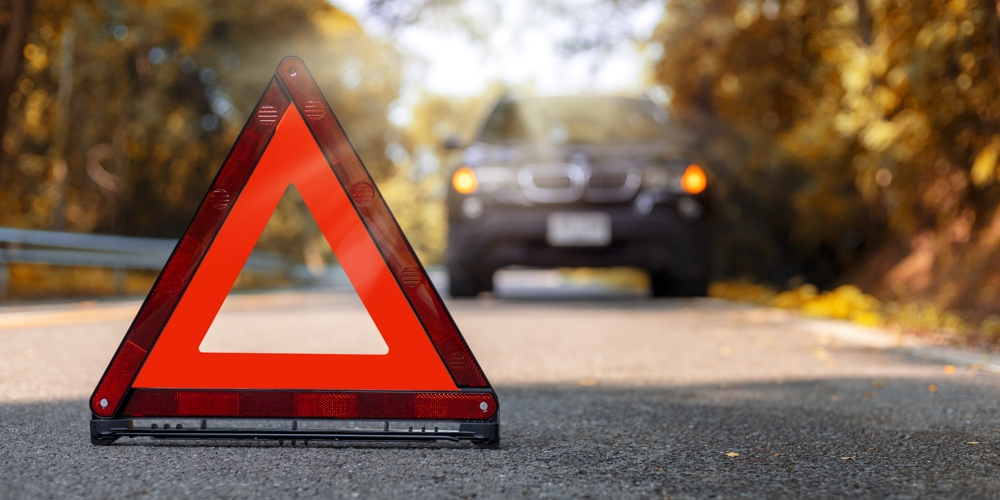
This information considers a range of driving emergencies and ways that you might deal with them.
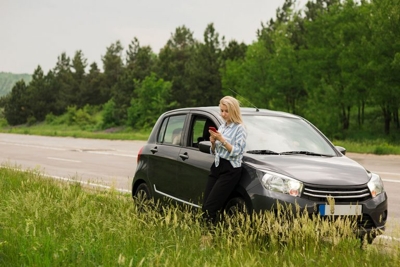 The ideas are mainly 'common-sense' and will seem obvious when you read them here, but remember that in a 'panic' situation common-sense can often be lacking unless you have primed and prepared yourself in advance.
The ideas are mainly 'common-sense' and will seem obvious when you read them here, but remember that in a 'panic' situation common-sense can often be lacking unless you have primed and prepared yourself in advance.
With this in mind it might be a good idea to mentally rehearse being in a situation as you read about is - and using the tips to safely resolve the situation.
It's important to remember that the emergencies listed are not common, especially in modern cars. You might never experience these emergencies or only experience one of them in a lifetime of driving.
All of the 'fixes' have been used successfully by someone somewhere in the world but are offered here without warranty, simply because there are so many different sets of circumstances associated with driving emergencies it would be impossible to give advice that would work in every case.
Although faults with brand new vehicles have caused emergencies with recalls over the years for faults that cause brakes to fail, accelerators to stick, doors or bonnets to fly open or cars to catch fire, major faults with new cars are relatively rare.
You can avoid becoming the victim of a mechanical emergency by always keeping your car well maintained with regular servicing and by doing basic daily and weekly vehicle checks.
The risk of driving emergencies can be minimised by making sure that you fully understand the capabilities of the vehicle you are driving and following safe driving practice, sticking to the rules of the road.
 Perhaps easier said than done, but just like you can learn everything else in life, you can learn how to stay calm.
Perhaps easier said than done, but just like you can learn everything else in life, you can learn how to stay calm.
Be educated and prepared:
The information here will help, and you can find more in libraries or on the internet or take courses in first-aid or other related things.
Take stock:
Spend a moment to weigh up the situation. This might only be a few seconds in some situations but it will be time well spent.
Breathe deep:
Practise deep breathing so that you will be ready to use it to calm yourself, Inhale slowly counting up to five as you do so, hold your breath and count to five, slowly exhale counting to five. Repeat this exercise several times and remember that it will help to calm you in an emergency.
 "There was such a mess when I arrived... I didn't know what to do or where to start..."
"There was such a mess when I arrived... I didn't know what to do or where to start..."
It just might be that one day you are the first, or only, person to arrive at the scene of an accident, or you may be involved in an accident but uninjured. Would you know what to do?
The advice on this page is basic, simple, and can save lives. You will also find a couple of videos from the UK Open University explaining what paramedics do at the scene of an accident.
1. Warn others:
Park your car with hazard lights and/or headlights on ideally facing approaching traffic. Place a warning triangle in the road.
If there are other people who can help send them back along the road to warn and slow down other traffic. Take care on fast moving roads ... Other drivers might not understand what you are trying to do.
Although warning others might take precious minutes it will help prevent further danger and reduce the risk for you and all involved.
2. Further reduce risks and get help
Check the scene, switch off engines, impose a no smoking ban. Keep children at a safe distance.
Send someone for help or use your mobile phone. The UK emergency number is 999 (or 112 on a mobile. Call 911 in the USA.)
Click here for a list of worldwide emergency numbers. Dial the emergency number and when the operator answers, state the service required.
Give the following information:
Your telephone number (if you are cut off the emergency service will be able to contact you)
The location of the incident: Road names or numbers, landmarks, map reference, sat-nav positioning reference, etc.
Description of the incident, for example, "Motorcycle has hit a bus - the motorcyclist is not moving"
3. Assess casualties/injuries
The quiet casualties are probably the worst injured. Reassure the noisy ones that help is on the way.
4. Simple first aid:
 After completing the tasks above you can help those who need attention.
After completing the tasks above you can help those who need attention.
Don't move casualties: You may cause further injury. The only exception would be if there was further imminent risk and danger to life, for example fire.
Check for breathing: If the casualty is not breathing, clear the mouth (false teeth, chewing gum, sweets) very gently tilt the head back and, holding their nose, gently blow into them at five second intervals allowing the chest to exhale naturally. See the links below for detailed information and methods.
Stop bleeding: Firm pressure on a wound will stem bleeding.
Don't give casualties anything to eat or drink: This can cause complications for medics and delay life saving treatment.
Learn more:
Note that the information above is a very bare minimum. There are also different schools of thought on best practice - with modern thinking being that a 'hands only' chest compression method works just as well as mouth-to-mouth resuscitation.
Attend a first aid course to learn the basics of first-aid. It's easy to save lives with simple skills that can be learned in just a few hours.
Stay calm - stay safe!
The UK Highway Code states:
If you are involved in a collision which causes damage or injury to any other person, vehicle, animal or property, you MUST
stop. If possible, stop in a place of relative safety
give your own and the vehicle owner’s name and address, and the registration number of the vehicle, to anyone having reasonable grounds for requiring them
if you do not give your name and address at the time of the collision, report it to the police as soon as reasonably practicable, and in any case within 24 hours.
For full information about breakdowns and accidents from the Highway Code click here.
The video below gives advice about action at the scene of an accident.
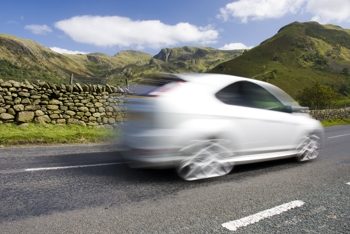 "The car had a mind of it's own - it felt like I was on a roller-coaster"
"The car had a mind of it's own - it felt like I was on a roller-coaster"
The information below will help you to prepare for an emergency that will only ever effect a very small handful of the world's drivers.
A stuck accelerator pedal is a rare and unusual problem, however, if your accelerator sticks down or the pedal linkage breaks, causing the car to keep accelerating, it can be very scary.
Stay calm! This might be easier said than done for some people, but you can reassure yourself right now that you have control.
Your vehicle brakes have immense power - check this by driving you car at about 40 miles per hour on an empty road (approx. 60kph) and gently (be very careful!) pressing the footbrake with your left foot, gradually increasing the pressure to slow the car down.
By doing the exercise above you will not only reassure yourself, but you will also have gained some practical experience of how the car will feel in an accelerator emergency. All of the following actions will be almost simultaneous, but by rehearsing them in order in your mind you will be fully prepared in the event of an emergency.
Brake firmly:
The first thing is to brake firmly to counteract the effects of acceleration. Remember, your brakes have lots of power. The footbrake should be sufficient - avoid temptation to use the handbrake because it might cause a sideways skid.
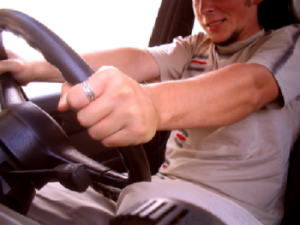 Press the clutch in a manual car:
Press the clutch in a manual car:
In a manual car pressing and keeping the clutch down will normally be sufficient.
Press the clutch down to disconnect the engine from the wheels. When you press the clutch the engine may start to over-rev but in most cars this will be cut by the engine management system. In a worst case scenario you could wreck your engine by over revving - but you would still be alive!
It can then help if you knock the gear lever into neutral.
Select neutral in an automatic:
In an automatic, move the selector to the neutral position.
Pressing the footbrake might also be sufficient in an automatic - use both feet to press the pedal progressively and firmly.
Look for an escape route:
While braking look out for an escape route - this could be the hard shoulder on a motorway (freeway). If changing lanes avoid sudden steering; swerving the car could lead to loss of control - if possible keep in a straight-line.
After you stop switch off:
As soon as the car is stopped and safe, switch off the engine.
Important:
Do not turn off the engine when the car is moving if your car has an ignition key. This is because you might accidentally activate the steering lock leaving you travelling at high-speed with no steering!
Some cars with a push-button start will allow you to switch off the engine safely in an emergency situation while the car is moving. Check your car handbook to find out if this is possible with your car. Typically this would require a 'long press' on the start button. But beware - turning off the engine will disable your power steering and reduce the efficiency of servo assisted brakes if the pedal is pumped two or three times in a car with an internal combustion engine.
Using some, or all, of the ideas above you should be able to stop in a few seconds.
If the problem is intermittent, contact your dealer - do not drive the car unless the dealer says it's OK to do so.
Some cars are fitted with smart-pedals that recognise that brakes take precedence over acceleration. This means if both pedals are pressed simultaneously the software forces the engine to respond to only to the brake and decelerate. These systems can help prevent 'unintended acceleration' particularly if the cause is a mechanical problem such as a floor mat jamming the pedal or a damaged pedal linkage - this is because they work directly with the engine management system.
 Avoid the temptation to try to un-stick the accelerator by bending down and pulling at the pedal. Even if you can see that the pedal is 'down'. the problem is likely to be somewhere else - in the linkage or engine management system for example.
Avoid the temptation to try to un-stick the accelerator by bending down and pulling at the pedal. Even if you can see that the pedal is 'down'. the problem is likely to be somewhere else - in the linkage or engine management system for example.
The only exception to this advice would normally be if there is an obvious cause that you can fix without being distracted from the road - an example might be the pedal getting caught under a mat in the foot-well, or something loose, for example a drinks can, jamming the pedal. Having said this - these problems are likely fixable by hooking your foot under the pedal or kicking the can out of the way.
After stopping make sure you know what is happening all around, especially on multi-lane roads, to reduce the risk of further danger.
Stay calm... Stay Safe!
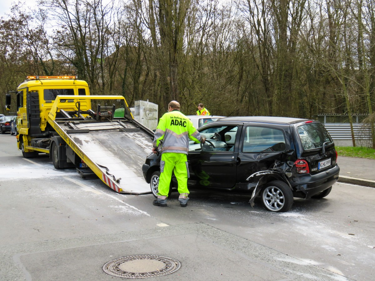 "It all happened so fast - the car just went out of control... There was nothing I could do about it."
"It all happened so fast - the car just went out of control... There was nothing I could do about it."
Tyre blow-outs and other tyre failures have been around as long as there have been pneumatic tyres on motor cars.
The good news is that modern tyres are far more robust than they were even 20 years ago, but occasionally they still fail, and sometimes when driving at speed.
When tyres fail people will often say things like "There was nothing I could do about it", but in reality...
It usually takes several months of neglect or bad driving for a tyre to 'burst'
Every time you drive up a kerb, through a pothole that you could have avoided, park with your tyres pressing against a kerb or leave weeks between tyre pressure checks you are adding, bit-by-bit, to the likelihood of a tyre failure.
As with many mechanical emergencies the starting point here is avoidance - look after your tyres a bit better to avoid the risk of finishing your journey in a recovery truck! The single most important thing that the average driver can do is to check the tyre pressures regularly - incorrect pressure is a major cause of tyre failure and increased fuel consumption.
Legal note: Having the correct tyre pressure is a legal requirement. More information from tyresavings.com.
If you look after your tyres but are still unlucky enough to get a blow-out or high speed puncture the guidelines below will help you to cope and perhaps avoid an accident.
Below you will find a video explaining how to deal with a blow-out in a large recreational vehicle - this will show the dynamics of a vehicle when a tyre blows, the same principle apply to smaller vehicles.
You might hear your tyre fail, and you should definitely feel the effect.
The immediate noise of a tyre failure might be a loud boom or bang as the tyre bursts and/or there could be a a 'whooshing' sound of the air escaping from the tyre. After the tyre has failed there might be a 'flapping' sound as the deflated tyre (or what's left of it) hits the car bodywork or the road as the wheel continues to rotate. Whatever else happens you will notice that the car will feel 'wrong' - particularly the steering.
Experts differ in their opinions about whether a front or rear tyre failure is the worst but in reality any blow-out has the potential to cause serious problems. There are several factors that will affect the severity of any incident, these include speed, vehicle loading, front or rear wheel drive, road conditions and more besides.
In extreme cases a blow-out can lead to loss of control, but it's more often the driver's response that causes or worsens the danger - that is why the information below is important.
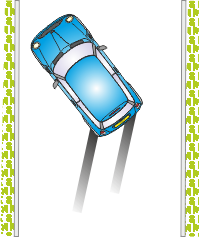 Your car will tend to weave about, especially at speeds over 50mph. The best action is to hold the steering wheel firmly and let the car slow down by itself.
Your car will tend to weave about, especially at speeds over 50mph. The best action is to hold the steering wheel firmly and let the car slow down by itself.
Your immediate instinct might be to brake, but if the car is starting to move sideways, braking will make matters worse causing the car to spin.
Sudden braking is the single worst thing that you can do if a tyre blows out. Repeat this thought to yourself over and over so that you are programmed to act if the worst happens.
Keep looking ahead and turn your steering wheel to keep in a straight line. Maintain momentum by accelerating and then ease off the gas to slow down - accelerating is not done to speed the car up, simply to maintain momentum and to minimise the risk/effect of a side-slide. Changing to a lower gear might help in a front wheel drive car if you can control the steering with one hand.
Front tyre punctures and blow-outs will cause the car to pull heavily to one side. Steer firmly to correct the pull.
Leave the footbrake alone... If there is space ahead, concentrate on steering and allow the car to lose speed naturally. If you use the footbrake after gaining initial control, be very gentle.
Pulling the parking brake on and off repeatedly can help you to slow down, but, care must be taken not to lock the back wheels because this could cause the car to pivot around the damaged front wheel and spin out of control - your main aim is to keep the car on course and lose speed naturally.
Changing down might help in a rear-wheel drive car. The engine compression will reduce the speed but again, no snatched or jerky changes. Bearing in mind that extra effort will be required for steering, it might be safer to keep your hands on the wheel and leave the gears alone.
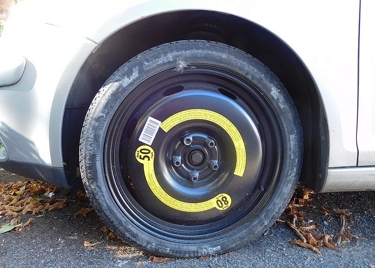 Burst tyres are dead. You can drive on the tyre very slowly to a safe place but do not attempt to go any further than is absolutely necessary.
Burst tyres are dead. You can drive on the tyre very slowly to a safe place but do not attempt to go any further than is absolutely necessary.
The only time it is safe to keep driving (after inspecting the damage) is if you have a puncture in a 'run-flat' tyre (a blow-out could make even run-flat tyres unusable). More information about run-flat tyres here.
Repairable punctures can turn into irreparable tyres if you drive on them. Read your car's handbook for information about jacking your car safely and changing a wheel.
If you have a space-saver spare tyre (shown in the picture), keep your speed down - your car will not be as stable as with the full size tyre - your car handbook will give full information - the maximum speed will also be shown on the wheel/tyre.
Tyre checks:
Check your tyre pressures weekly
Check tyres for damage weekly with a quick visual check every day
Check your tyres before long journeys
Check you handbook for correct tyre pressures for different vehicle loads
Check your tyre pressure more often during heat waves
Stay calm - stay safe!
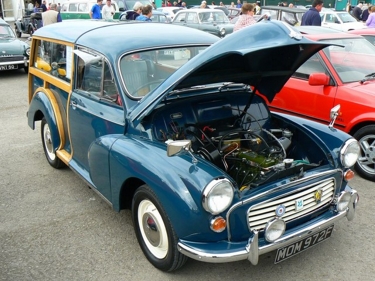 "There was a bang and then I couldn't see anything... It's natural to panic isn't it? I suppose it was just bad luck!"
"There was a bang and then I couldn't see anything... It's natural to panic isn't it? I suppose it was just bad luck!"
OK. It's good that you remembered to check your oil and other stuff 'under the hood', but make sure your bonnet is properly closed when you've finished.
I can testify from personal experience that a bonnet flying open when driving along can be quite a shock...
It happened to me in the 1970's in a Morris Minor Traveller - like the old car shown in the picture.
I was driving at about 40mph when there was a terrific bang - strangely enough the noise seemed to hit me before the fact that I couldn't see anything ahead!
Luckily it was summer and my driver’s side window was open; I was able to hang out and see enough to bring the car safely to a stop. It's not something that you want to learn by experience!
If you notice that your bonnet looks loose as you drive along, stop and check it. Don't wait until you get home - you might not!
The worst danger if your bonnet flies up is that you will do something silly because of the shock. It will take a moment to realise what has happened, there is a loud bang, the windscreen may break, and then you can't see anything! A natural reaction is to brake hard and fast.
Think quickly and overcome this natural urge!
Braking hard will frighten the driver behind, who will almost certainly be following too close, thus doubling the problem and possibly resulting an a heavy rear end smash.
If you have been keeping a safe distance there will be no danger from the vehicle in front. If the road bends you should be able to see where it goes by looking out of the side windows. The greatest danger is instability, due to wind resistance, and from traffic following closely behind.
 Check your mirrors (all of your mirrors).
Check your mirrors (all of your mirrors).
Hold the steering wheel firmly to counter wind resistance.
Brake firmly only if it's safe to do so.
If you are on a motorway move over to the hard-shoulder before braking. Try to look out of the driver's window. Ask your front passenger (in a gentle scream) to look out on their side.
Remember, the worst danger in this situation comes from you. Stay calm - stay safe!
"I was driving down this hill and suddenly my brakes failed... There was nothing I could do except pray!"
Regular servicing will ensure your brakes are in good working order. Sudden brake failure in well maintained cars is possible but you are perhaps more likely to be hit by lightning!
If you are not already doing so, start a routine of testing your brakes every time you drive. Brake tests only take a few seconds to do and will soon become a habit.
There are two checks that you can make - Static and Rolling.
Static brake test:
The static brake test is just a matter of pressing the brake pedal two or three times when you get into the car.
There should be resistance from the pedal; if there isn't and the pedal easily pushes to the floor you have probably got a fluid leak that has drained the fluid from the system - it's highly likely that there will be visible signs of this on the ground under the vehicle. If the pedal feels 'spongy' but has some resistance it's likely that there is air or moisture in the brake fluid - this will reduce braking efficiency and could be a sign of impending total failure.
If your brake pedal is not firm after two or three presses do not drive the car - seek assistance from a mechanic.
Rolling brake test:
Complete your 'rolling brake test' by pressing the brake pedal gently as soon as possible after moving off and while driving slowly. This will reassure you that your brakes are OK before you need them.
Note: this is not an emergency stop! Simply 'feel' the brakes at five or ten miles per hour.
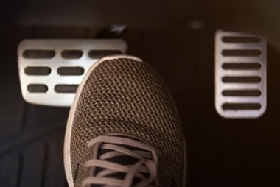 Brakes operate on a hydraulic system; for the system to work effectively there must be fluid in the hydraulic pipes. If the fluid starts to leak from the system the brake pedal will often travel further when pressed - other problems can include air bubbles in the hydraulic fluid.
Brakes operate on a hydraulic system; for the system to work effectively there must be fluid in the hydraulic pipes. If the fluid starts to leak from the system the brake pedal will often travel further when pressed - other problems can include air bubbles in the hydraulic fluid.
You don’t need to know anything about hydraulics!
If your brake pedal feels soft or 'spongy' stop immediately and get a breakdown mechanic to check the car.
When the brake pedal feels soft/spongy on the move, you might be able to build up brake pressure by repeatedly pumping it, however, this is only an 'emergency' measure to stop the car once - it is not a 'get you home' solution. Driving with a 'soft' brake pedal is extremely dangerous because your brakes could fail at any moment, even if they don't fail they will be inefficient, possibly leading to an accident.
If your brake pedal feels unusually hard and the brakes are not working or are inefficient, something might have broken in the braking system. BUT...
It could just be that something is jammed under the brake pedal. This is why you should keep the floor area of your vehicle free of litter and other stuff that could slide under the pedals.
Total brake failure is rare, however, you will see from news stories that it occasionally happens - BMW, Ferrari, Vauxhall, Volkswagen and Toyota are among several brands that have recalled vehicles because of possible brake defects - if you get a recall notice from your dealer/manufacturer act on it immediately.
If you need to stop 'now!' you can use a hand operated parking brake (handbrake) in an on-off pumping motion, keep the release button pressed as you do this.
If there's time, change to second gear and bring the clutch up gently (the engine compression will make the clutch feel like a brake) then use the parking brake to stop. In an automatic, shift to 'low' - if there is a manual option on your auto, change down one gear at a time.
If you have a pedal operated parking brake you need to operate the brake release handle at the same time to avoid locking the rear wheels - parking brakes only operate on the rear wheels (with very rare exceptions).
Warning: Using the parking brake or dropping a gear at high speed could be dangerous and lead to a loss of control - lose as much speed as you can naturally before doing either of these things.
If you use the parking brake pull it gradually - a sudden tug on the brake or push on the parking brake pedal could lock the wheels and lead to loss of control. Locking the wheels might slow the car quickly in a straight line but the resultant skid could make the vehicle uncontrollable, possibly skidding off the road.
If you have an electronic parking brake only use it in a last resort emergency - these brakes tend to operate on an 'on/off' basis and will probably lock your wheels solid.
Another method is to change to a low gear and switch off your engine. However, extreme caution is required if this is done. You must have a straight run off space in which to stop; this is because your power steering will fail as soon as the engine is switched off - it could be almost impossible to turn the wheel in some cars.
A second danger of switching off the engine is that the steering lock could engage; in some models this can happen even if the key is still in the ignition switch. Find out how your steering lock operates now - if you wait until your brakes fail it will be too late.
It is reassuring to note that most cars built since the early 1990's have 'dual circuit' brakes which will still work on at least two wheels in the event of a hydraulic system failure. Dual-circuit brake systems are a safety feature that effectively incorporates two separate hydraulic systems, if one fails the other still operates.
![]() In absolute extreme situations you may need to 'crash' your car in order to stop - however, this is an extreme absolute last resort action.
In absolute extreme situations you may need to 'crash' your car in order to stop - however, this is an extreme absolute last resort action.
If you make the choice to crash, avoid sudden deceleration which will lead to total loss of control. It is essential to control then crash as much as possible. The idea is to 'drag' the car to a halt.
You MUST NEVER crash head on into objects or vehicles.
When the car has slowed down using other methods (above), you can 'crash' by running parallel along a crash barrier or a wall. Doing this will cause extensive damage to your vehicle. In the absence of walls or crash barriers their might be a kerb but you must be aware that a kerb can only be used if you have full control and can keep the car straight - hitting a kerb hard, at an angle or at speed, can flip a vehicle over. If there is an opportunity to run off into gravel or a muddy verge that will also slow the car but only do this if you can steer a straight line - wheels can 'dig in' if you turn on soft ground causing the car to flip over.
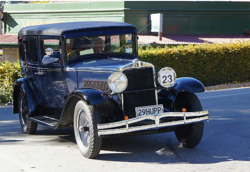 Brake fade refers to a situation where the brakes lose efficiency (or possibly fail completely). It is extremely rare in modern, well maintained vehicles.
Brake fade refers to a situation where the brakes lose efficiency (or possibly fail completely). It is extremely rare in modern, well maintained vehicles.
There are two causes of brake fade.
The most common, and the one which was experienced by motorists in the first part of the 20th century, is caused by overheated brake linings (the bits that press onto the wheel to slow it down).
You will find that however hard you press the brakes they won't slow you down the way that you would expect them to.
This sort of brake fade is rare with modern disc brake technology and normal on-road driving - you would need to brake long and hard down a (very, very) long hill, have an overloaded vehicle or be driving 'on the limit'. When the brakes cool down they work OK again.
The second type of brake fade is caused by water in the brake fluid.
When the fluid gets hot, the water can vaporise. Steam (unlike brake fluid) will compress - therefore instead of your braking effort being transmitted to the wheels, it is dissipated as the steam compresses. When the system cools down the brakes will seem OK again. If your car is regularly serviced, the brake fluid will be replaced periodically and this problem will never arise.
With this second type of brake fade the pedal can feel spongy or go down to the floor with no effect.
If your parking brake (handbrake) fails, leave the car in first or reverse gear (or Park) and chock your front wheels against the kerb when you park. It is not wise to leave your car on a hill even with the wheels chocked.
Stay calm - stay safe!
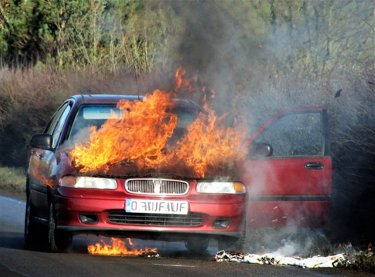 "I got out to open the bonnet and check where the the smoke was coming from... The next thing I remember was waking up in the local hospital wrapped in bandages"
"I got out to open the bonnet and check where the the smoke was coming from... The next thing I remember was waking up in the local hospital wrapped in bandages"
The first thing to remember about car fires is that they are fairly rare, even in accidents. However, if you have ever driven past one it might have left you with a vivid memory of the event.
The good news is that fires are not only rare, but manufacturers have minimised the risk. Modern car design puts the petrol tank in a position where it is unlikely to be damaged in all but the worst accidents.
The main cause of vehicle fire is faulty wiring. In turn this can easily come about because of neglect or sloppy do-it-yourself electrical repairs.
It is not wise to fit electrical accessories to your vehicle unless you are absolutely sure about what you are doing. The cost of a good auto-electrician will be far less than the problems that come with a car fire.
If you suspect a fire on the move you need to take prompt action - it only takes a few minutes for a fire to develop into an inferno like the one shown in the photo.
If the fire is inside the car, for example, smoke coming from behind the dashboard, stop immediately turn off the ignition and get out of the car as quickly as possible - there is a real danger that the car will quickly fill with highly toxic smoke and fumes.
If the fire is under the bonnet:
Choose a safe place to stop, away from places where the fire could spread if the car burns out - but don't waste time!
Switch off the engine and get our of the car and DO NOT OPEN THE BONNET. Opening the bonnet allows more air to get to the fire and might make it flare up.
If you have a fire extinguisher, loosen the bonnet just enough to aim it underneath. If you can't do this, stand back and call for assistance.
Fires, especially electrical fires, take hold very quickly. It is not normally a good idea to try and unpack your belongings from the boot, etc. If there is time, grab what you can, otherwise stand well away. Although petrol tanks are well protected from impact, they can explode in a fire. The tyres can also explode throwing off burning debris - so keep your distance!
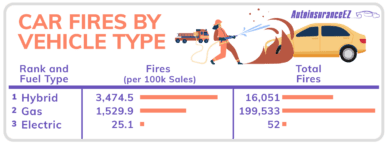 Data has shown that contrary to what some believe electric cars (EVs) are dramatically less likely to catch fire than other vehicles. However the same is not true for hybrid vehicles - these have been shown to have a higher risk than other cars, including petrol engined cars. (Data analysis on cars in the USA by AutoinsuranceEZ)
Data has shown that contrary to what some believe electric cars (EVs) are dramatically less likely to catch fire than other vehicles. However the same is not true for hybrid vehicles - these have been shown to have a higher risk than other cars, including petrol engined cars. (Data analysis on cars in the USA by AutoinsuranceEZ)
Electric vehicle fires where the batteries catch fire are certainly not something that you can put out yourself with a small fire extinguisher - it was reported that a Tesla fire took several hours and 100,000 litres of water to put out.
The main cause of EV fires is if a battery is exposed to excessive heat or there is penetration into the battery case causing a short circuit, this in turn creates a chemical reaction that generates heat faster than at can be dissipated (a process called 'thermal runaway').
In both hybrid and fully electric cars make sure that you are alert to any warning lights and act immediately (which of course you should do in any car). Follow the manufacturers instructions for charging and other 'user maintenance'.
As with all car fires get passengers out immediately and well clear - apart from the danger of explosion there is also a greater risk from toxic fumes when electric car burn.
Earth or sand can be useful for putting out fires in the absence of an extinguisher. A car rug or mat might be useful for smothering a fire. Don't use water on petrol fires, you may wash the burning petrol somewhere where it will cause more problems.
Electrical fires can be stopped by disconnecting the battery or the appropriate wire. However, you should not attempt to do this unless you know what you are doing and can easily access the battery (or wire) without the risk of burns.
 Always, always, always, get your passengers out of the car before doing anything else if you suspect fire.
Always, always, always, get your passengers out of the car before doing anything else if you suspect fire.
As explained above, toxic fumes can fill the car very quickly. Make sure that passengers (especially children) and pets are well out of harm's way, especially on motorways and other fast roads. Other drivers will be distracted and 'secondary' accidents can easily happen.
Stay calm - stay safe!
This eight minute video from Transport Evolved was made in 2018, but contains valid information that you might be interested in.
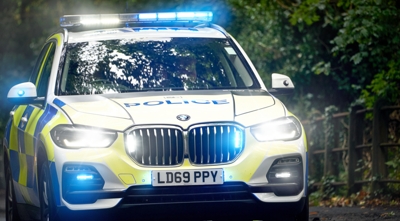 What do you do when you hear an emergency vehicle approaching?
What do you do when you hear an emergency vehicle approaching?
Do you stay where you are and risk blocking the way?
Do you stop?
Do you swerve to the left or right?
It's all too easy to over-react when an emergency vehicle approaches - especially when a driver only notices the vehicle at the last moment.
If your first warning of an emergency vehicle that is close behind is the siren, you have not been checking your mirrors nearly as often as you should be.
Use your mirrors often - if you hear a siren in the distance look out for the problem, don't wait for it to find you! Scan the road well ahead and in your mirrors for blue lights and keep a look out for safe places to pull in if necessary.
When an emergency vehicle arrives in your vicinity your first reaction might be to brake... But this can cause problems if there is not a clear space for the vehicle to pass. Look for the safest option, a place where you can slow or stop with plenty of room for the driver of the emergency vehicle to pass. It's not usually a good idea to speed up or cross red lights to get out of the way - doing this can endanger you and others on the road and crossing red lights is still illegal.
Help emergency drivers and other road users by signalling clearly to show that you are pulling over. make sure that when you pull in you are not making things worse... For example, if you pull into a gateway or side road, check your mirrors to make sure that it is not the entrance that the emergency vehicle is heading for. Also avoid stopping in places where it will be difficult for the emergency driver to pass - for example, the brow of a hill on a bend or near traffic islands.
Stay calm
Don't make rushed decisions
Always be on the lookout for safe places to pull in
Stay within the rules of safe driving and the law
Remember that drivers of emergency vehicles are highly trained professionals - they will cope with any situation, but you should aim to help them, the best way you can do this is by staying calm and avoiding panic decisions.
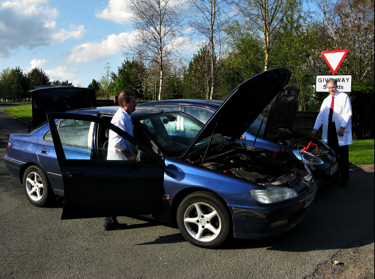 If your response to the title 'Flat battery' is:
If your response to the title 'Flat battery' is:
"What shape should it be?" You would be best advised to call out a mechanic if your car fails to start!
This is about batteries that are used to start internal combustion engines (including hybrid cars).
We stress that the advice on this page is for general guidance only. Consult your vehicle handbook for detailed advice relating to your make and model.
If your car engine is sluggish when you turn the ignition key,or there is just a clicking sound, there is a good chance that you have a flat battery. The way to check is to switch on your headlights - if they are dim, or fail to work, the battery is flat.
You can 'bump' or tow start a car with manual transmission using the method explained below, however, you must be aware that this method can shorten the life of your catalytic converter, therefore, if you car doesn't start more or less straight away when you try to bump start, abandon the attempt (also, don't use this method repeatedly - get the car fixed!). You cannot 'bump start' a car with automatic transmission.
Push-Start (Bump-Start/Tow-Start):
With the ignition switched on and the handbrake released, select 2nd or 3rd gear and hold the clutch down. Tow, push, or allow the car to roll down a hill until you are doing 8 to 10mph and then engage the clutch briefly - the engine should start. You can do this with a 'bump' by engaging the clutch and then immediately disengaging it to allow you to 'rev' the engine. Note that this will not work for all cars in all situations (and not for automatics).
Perhaps a better method of starting is to use 'jumper leads'. However, before trying this, check the handbook to make sure that it is OK for your model - some engine management systems could be damaged using this method. Also ensure that the other vehicle operates at the same voltage (most cars use a 12v system, most trucks use 24v).
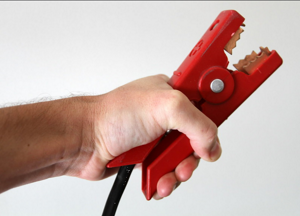 Note that this method is not suitable for batteries where there is clear physical damage such as a crack - trying to jump damaged batteries can be extremely dangerous with a risk of explosion - and will be pointless because the damaged battery will discharge within a minute or two of being charged.
Note that this method is not suitable for batteries where there is clear physical damage such as a crack - trying to jump damaged batteries can be extremely dangerous with a risk of explosion - and will be pointless because the damaged battery will discharge within a minute or two of being charged.
You will need a set of jumper (jump) leads. Jump leads are simply heavy duty cables with large 'crocodile' clips that are used to connect your battery to the battery of another vehicle. You should also wear safety goggles or spectacles to protect your eyes from sparks or in the unlikely event of battery damage - acid splashes.
First, turn all the accessory switches off on your car (radio, wipers, lights, screen heater, etc.); there are two reasons for this:
Check to see which side of the cars the batteries are situated on and then manoeuvre the car with the good battery to ensure that the batteries are as close together as possible allowing 'slack' in the jump-cables when they are attached.
Make sure that the cars are not touching each other.
Connect the red leads:
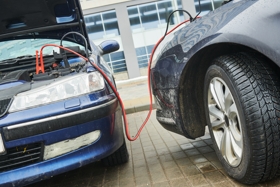 Connect the red lead to the positive battery terminals of each car starting with the dead battery. The positive terminals will often have a red cover and be clearly marked with a plus sign (+). In older vehicles you might have to clean the terminals and the area around them to see the + sign. Make sure that the leads make a good connection - you can do this by scraping the terminals to show bare metal.
Connect the red lead to the positive battery terminals of each car starting with the dead battery. The positive terminals will often have a red cover and be clearly marked with a plus sign (+). In older vehicles you might have to clean the terminals and the area around them to see the + sign. Make sure that the leads make a good connection - you can do this by scraping the terminals to show bare metal.
The reason for connecting the red leads first (+) is to minimise the risk of a 'short circuit'.
Connect the black leads:
After you have connected the positive leads, connect the black negative leads.
Connect the black lead to the negative pole, marked with a minus sign (-) of the good battery and then to a bare metal part of the engine on the car with the flat battery (at least 45 centimetres from the battery for safety).
The reason that it is better to make the connection to a bare metal part of the car rather than directly to the battery is to minimise the risk from sparks around the battery itself which in extreme situations could lead to an explosion (due to the ignition of hydrogen released from the battery when it is charging).
Although exploding batteries might be very rare the consequences can be horrific (as they are filled with acid) if you do connect directly to the negative pole of the dead battery you should wear eye protection - just in case you are the 'one in a million'.
Expect that the leads may spark slightly when you attach them and be extra careful to make sure that the black lead clamps DO NOT come into contact with the red lead clamps or positive terminals of either battery.
Start the engine of the car with the good battery and allow it to run for a few minutes to give the flat battery a charge.
If the dead car won't start it's likely that you didn't allow enough time for charging, if this is the case, make sure that the jump leads are making a good, tight contact and allow the good car to run for longer before trying again.
A clue that the battery is charging is that the dead car's instrument warning lights will start to come on as normal (ignition light, oil light, etcetera).
Allow the engine to run for a few minutes then switch off to see if it will start on its own. If not, the charging system is either not working at all or not working properly and the car might not get you home.
Remove the cables as follows - remove the black lead from the previously 'dead' car first and then from the good car, being careful to keep the ends of the cables away from the red lead terminals. Then remove the red lead - first from the 'good battery' and then from the newly charged battery being careful not to touch any metal part of either vehicle when doing so.
If you are unsure about what any of this means, DO NOT attempt a jump-start - call a breakdown mechanic.
Stay calm - stay safe!
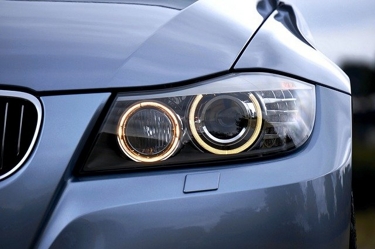
Carrying a torch in the car can be useful... At least you will be able to see and be seen if you have to walk for help!
Some drivers are not aware that it is an offence to have headlights that do not work correctly, even if you only drive in daylight. For a vehicle to be considered roadworthy all lights must be in working order and in the case of headlights, must be correctly aligned.
The Highway code tells us that we must (legal requirement):
ensure all sidelights and rear registration plate lights are lit between sunset and sunrise*
use headlights at night, except on a road which has lit street lighting. These roads are generally restricted to a speed limit of 30 mph (48 km/h) unless otherwise specified
Use headlights when visibility is seriously reduced, generally when you cannot see for more than 100 metres (328 feet). You may also use front or rear fog lights but you must switch them off when visibility improves
*The hours of darkness are defined as the period between half-an-hour after sunset and half-an-hour before sunrise.
Whether you are driving a company car, hire car, borrowed car or your own vehicle, as the driver you have a responsibility to ensure that it is roadworthy. The excuse "It's not my car officer" is likely to cause more problems than it solves!
With the above in mind you should check all your lights before every journey after dark and as a minimum check your lights as part of your weekly vehicle checks. If you suspect a problem with your lights (for example if they seem to be dimmer than usual) get them checked out by a garage - don't wait for them to fail! It's not unusual to see vehicles with just one headlight working - where the driver doesn't seem to realise that they have a problem.
 Driving with only one headlight is extremely dangerous because other drivers might be confused into thinking that there is a motorbike coming towards them on unlit roads - but it becomes even more of a problem if the working light fails.
Driving with only one headlight is extremely dangerous because other drivers might be confused into thinking that there is a motorbike coming towards them on unlit roads - but it becomes even more of a problem if the working light fails.
If your headlights fail you might still have some light from sidelights and 'driving lights', but this would not be enough to continue your journey on unlit roads (and you would be driving illegally). If you are following another vehicle you can still follow its tail lights to stay safely on the road while you assess your situation and look for a safe place to park, otherwise follow the action steps below.
Firstly ease off the gas and brake gently, try the dip switch, you might still have full or dip beam available if your dipped lights fail (or vice-versa). The headlight flasher switch might also work if the problem is with the electrical circuitry - holding this could provide 'emergency light' until you can stop. Never stop suddenly
Next, try the light switch. It may be a bad connection in the switch so turn it on and off a a few times to see if anything happens.
If you still have no headlights, continue to brake to a halt - put on your hazard lights, on unlit roads a car with no lights is in a very vulnerable position.
If all your lights have failed (headlights, sidelights and rear lights) you might be able to reverse your car on to a verge or other safe place by reversing using the reversing light, brake lights or fog lights.
If you have no lights at all and are on an unlit road do whatever you can to move your car off the road or out of the main traffic flow - you will be able to see the other drivers but they probably won't see you. In this instance get your passengers out of the car and to a place of safety and alert the police immediately and explain your situation.
Even if your lights have failed your indicators, hazards lights or interior lights might still function - do whatever you can to make your car visible to others. If you have a reflective warning triangle place it on the road 50 metres behind your car (but not on the hard-shoulder of a motorway).
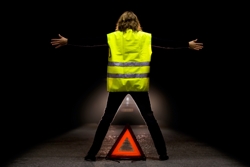
It's useful to keep a yellow reflective vest in your car for all emergency situations
If you are mechanically minded and have the car's handbook you could check the fuse box - but if you are unsure, leave well alone.
Carrying a torch in the car can be useful to help you diagnose this problem and any other night time issues - but never try to drive using a torch. Some very high powered modern LED flash-lights might help you to move the car to a safe place but it would perhaps often be better to use the light to warn other drivers of your predicament.
This information from Lifewire explains the causes of light failure and how to fix them (do not attempt repairs unless you are competent).
Stay calm - stay safe!
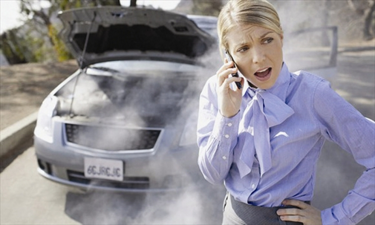 "The engine just started steaming... What could I do?"
"The engine just started steaming... What could I do?"
When did you last open your bonnet to check the engine coolant level?
When did you last look at the rubber hoses under your bonnet to check for leaks?
These are just a couple of the things that you could do in order to help prevent your engine from overheating.
The information below relates to petrol and diesel engined cars (including hybrid).
You will get an indication that all is not well when you see the engine temperature gauge rising or get a warning light showing that the operating temperature is above normal. You might also notice steam from under the bonnet.
Another sign inside the car is that your heater might start blowing cool air... This happens because the system is low on coolant. This won't necessarily mean that your engine is overheating but it is a sign that trouble is on the way!
There can be a number of causes ranging from severe engine problems to the car simply being fed up of sitting in a long summer traffic jam. The most common cause is a lack of coolant (normally a water and antifreeze mix) in the car's cooling system. This is your fault! Check the coolant as part of your daily checks.
Turn off your air conditioning - this lightens the load on your engine
Turn on the heating - this can make the car uncomfortably hot, particularly in summer, but it helps to take heat away from the engine (you'll have to figure out how to explain the fact that you are driving along naked if you are stopped by a police officer). If the heater blows cold air it's a possible indication that the engine is low on coolant fluid or there is a blockage in the engine cooling system.
Pull up in a safe place and wait for the engine to cool down - this could take an hour, possibly longer.
If you don't know the cause of the overheating call your breakdown service or 'limp' to the nearest garage when the engine has cooled sufficiently.
Opening the bonnet might help you to find out what the problem is if you know what you are looking for, but otherwise leave it shut.
WARNING: If you open the bonnet NEVER take the cap off a hot radiator or header tank in order to put in water... You will receive severe scalding from superheated steam. If you know what you are doing, wait for at least half-an-hour before attempting to add coolant and even then, cover the cap with a towel or coat (something substantial) and stand at arms length to protect yourself.
Stay calm - stay safe!
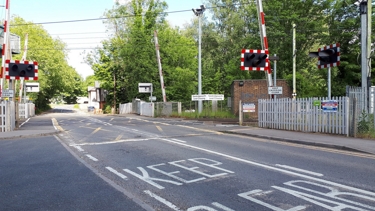 "The car wouldn't move and the barriers came down... I was terrified!"
"The car wouldn't move and the barriers came down... I was terrified!"
As with many emergency situations the first advice here is drive in such a way that you minimise the risk to yourself and others, the basic advice for this is never stop on a crossing. If there is a traffic queue, wait for the cars beyond the crossing to move so that you have a clear exit.
Although 'half barrier' crossings are being phased out there are still a few left in the UK - never try to beat the train by zig-zagging around the barriers - it could be the last thing you ever do.
The information below will help if you break down or stall on a crossing and the car won't immediately restart).
Emergency Tip: The best way to go when moving away is probably towards the train where possible - that way if a train does hit your car any impact will scatter debris away from you and the train will shield you.
Inform the signalman by using the track side telephone. If there is no telephone, call the emergency services (999).
If there is any sign of a train approaching, leave the car and join your passengers (run!).
If you are alone and have an older manual transmission car you could try moving the car by engaging a gear (second is probably the best) and turning the starter motor... This might be enough to 'jerk' the wheels free of the tracks and move the vehicle to safety - but this method won't work in modern cars with starter buttons or where the clutch or footbrake has to be pressed to start the engine.
You might be able to push the car clear, but remember the advice above: If there is any sign of a train approaching, leave the car and join your passengers (run!). Make sure that the parking brake is off and that neutral is selected before pushing (includes electric cars).
It is important to remember that trains are very heavy and can be 1000's of tons travelling at high speed - most cars weigh less than 2000kg. The train always wins when they fight!
If your vehicle breaks down, or if you have an incident on a crossing you should:
get everyone out of the vehicle and clear of the crossing immediately
use a railway telephone if available to tell the signal operator. Follow the instructions you are given
move the vehicle clear of the crossing if there is time before a train arrives. If the alarm sounds, or the amber light comes on, leave the vehicle and get clear of the crossing immediately.
The same advice applies to breakdowns on tramways.
Stay calm - stay safe!
 Several UK cities now have trams which share the roads with cars.
Several UK cities now have trams which share the roads with cars.
The Highway Code information relevant to this topic says:
Take extra care where the track crosses from one side of the road to the other and where the road narrows and the tracks come close to the kerb. Tram drivers usually have their own traffic signals and may be permitted to move when you are not. Always give way to trams. Do not try to race or overtake them or pass them on the inside, unless they are at tram stops or stopped by tram signals and there is a designated tram lane for you to pass.
If you follow the rules but still find yourself broken down on a tramway or crossing use the relevant advice from the railway crossing info above. Get passengers out, move the car if you can and alert the emergency services.
More advice about tramways in the Highway Code.
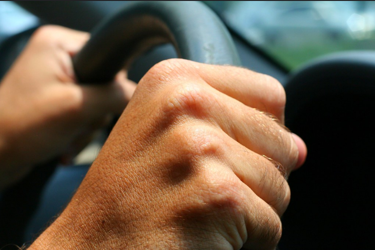 Don't try to drive the car to a garage if you feel the steering start to get heavier... Get the garage to come to you.
Don't try to drive the car to a garage if you feel the steering start to get heavier... Get the garage to come to you.
Steering failure is probably as common as alien abduction. Having said this it's useful to know about it (steering failure, that is!).
As usual, prevention is better than cure - but what can you do to prevent steering failure? The answer is 'probably not much' but one thing you should do if your car has hydraulic power steering is check the level of fluid in the steering reservoir during your weekly vehicle checks (see your car handbook for information).
The most likely cause of steering failure is a loss of power steering. This can happen if a hydraulic pipe breaks or is cut by debris from the road. Even in this eventuality it's unlikely that the power loss would be sudden. It's probable that the steering would gradually become heavier, thus giving a warning.
If your car has electronic power steering it is possible that this could fail suddenly - however you will still have some steering control, but it will take more effort to steer.
Symptoms of steering problems include:
Heavy steering.
Noise coming from the front of the car, particularly when steering is on full-lock.
Vibration in the steering wheel.
Steering pulls to the left or right
If you lose your power steering be prepared to hang on to the wheel with all of your strength to turn it. Stop as soon as possible. If the power steering has failed because the engine has cut out you may need extra pressure on the brakes to stop the car. Sometimes switching the engine off and on again can reset the system (never do this on the move).
Don't try to drive the car to a garage if you feel the steering start to get heavier, get the garage to come to you - stop as soon as you can, pull on to the hard shoulder on a motorway or to a safe parking position on other roads. Make sure that you take all the normal safety precautions, hazard lights, watch out for traffic, etc., especially if you are on a fast road or stopped in a difficult position.
The second type of steering failure is a breakage of the mechanical linkage. Although I have never heard of this happening, it is almost certain that it has happened to someone somewhere in the world. You will need to stop as quickly as possible. As you have no directional control this will probably be easiest if you just skid to a halt - but check behind first!
Steering can sometimes pull to one side... The most common cause of this is a soft tyre. If your tyres are OK get your steering checked immediately.
For cars with a key start.
It is highly unlikely that the steering wheel lock will fail while the car is moving - with 50 years driving experience and 45 years driver training experience the author has never heard of this happening, but it might have happened to someone, somewhere. If the steering locks on the move, stop.
Solutions (try in the order shown)
Usually the steering lock can be released by gently turning the wheel from side to side but occasionally the lock will jam completely. A common cause is that the load on the steering prevents enough movement to free the lock.
Move the car about a metre by pushing or letting it roll (if you are on a hill beware: the brakes may need to be pressed much harder than usual if the engine is switched off).
Jack up the front of the car lifting both wheels off the ground.
One of the methods above will remove the load on the steering and allow enough movement for the lock to be released normally.
If these fixes do not work you need a mechanic!
Stay calm - stay safe!
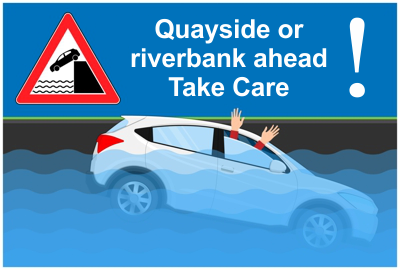 "It happened so fast ... I thought I was going to drown"
"It happened so fast ... I thought I was going to drown"
Sinking cars are more common than you might imagine. There has been more than one case where a car has driven into water after 'blindly' following sat-nav directions without question.
The 'how to avoid' rules here are about driving defensively.
Take care near quay-sides, river-banks and other situations where there might be deep water. For example, if you are driving along a road next to a river where there is no barrier it might not be wise to keep up to the speed limit.
Take extra care on slipways when the tide is in - especially in two-wheel drive cars. Ideally avoid them. Slipways can become greasy making it impossible to drive up them - there has been at least one tragic case where a driver and family passengers drowned when their car slid off a slipway into the rising tide.
It's reasonable to assume that the thought of being inside a car when it sinks must be one of the most frightening experiences imaginable for most people.
Sadly, it's been estimated by American Professor, John Hunsucker, that around 350 people die every year in sinking vehicles.
Occasionally cars drive off quay-sides or into rivers; other problems arise when the parking brake isn't applied properly and cars simply roll down embankments into lakes or rivers.
But as with all emergencies you can take quick controlled action to survive.
The action you take will perhaps depend on the situation that you are in. There are various expert opinions and there have been experiments to determine the best approach.
You might run off the road into a river or, with changing weather patterns, be swept off the road in a flash flood. With things happening that quickly your action may differ from a situation where there is more time, perhaps if your car rolls down a bank into a lake.
Whatever the situation, if you are in deep water you will have to get out as quickly as possible, but you will need as much energy as possible to swim and, possibly, to fight the cold. If the car has submerged quickly, fight panic by switching on the interior lights and breathing deeply. Switch on all the cars lights (if they still work) to help rescuers see where you are.
Some people suggest that you should shut the windows to slow down the rate at which the car fills with water. The theory is that the pressure inside and outside needs to equalise before you can swim out or attempt to open a door. However, the video below (shot in 2011) demonstrates that this is not a feasible option because it takes too long for the pressure to equalise.
If the car sinks before you can get out your only realistic option is to break a window (and rear window if there are passengers.
The universally recommended advice is that you should exit the vehicle as soon as possible The guidelines and videos below might help you to do this.
Release your seatbelts and open the windows - be aware that the seatbelts might not retract; take care not to get tangled
If your head restraints are removable, pull them out when you release your seatbelt to enable easy passage for rear passengers - you can also use the head restraints to smash the side windows if necessary. Learn how to quickly remove head restraints now.
If your windows jam, try to break them. You can get an 'emergency hammer' to keep in the car - alternatively any hard object. Banging on the glass with your fists is unlikely to break the windows. Note: Break the side windows - it's highly unlikely that you would be able to break the windscreen with a hammer because it is made from a different type of glass.
The car will sink 'heavy end' first (the heavy end is where the engine is). In deeper water it may flip onto its roof
In a car that sinks front first, there will be a bubble of air in the back, but you should stay in the front ... the front windows are often bigger and easier to get out of — for all passengers
The car won't sink immediately, even with the windows open, however you must use every moment to free yourself and passengers and get out. Push children out first (as shown in the second video below)
It may seem obvious - but don't try to save anything except lives. Computers, phones, purses, jewellery, etc. can be replaced - you can't!
If you are unable to open or break window, there is the equalisation option as a last resort. Keep your head. There should be enough air for the minute or two that it will take to prepare to escape. When the car is nearly full of water, take a deep breath and push a door open, you may need to do this with your feet (for extra strength). Note the wait: If you try to open the doors too soon the water pressure will defeat you and the energy required will take what little air you have in your lungs.
This video demonstrates how to rescue a child in the back of the car.